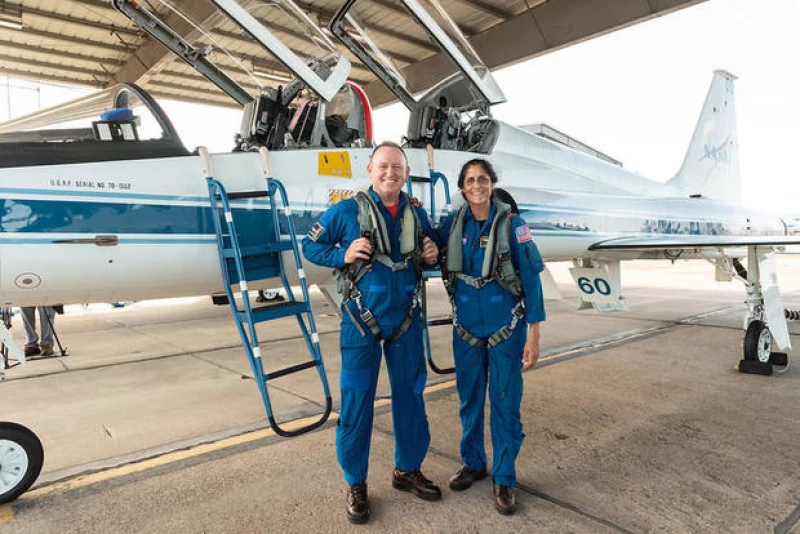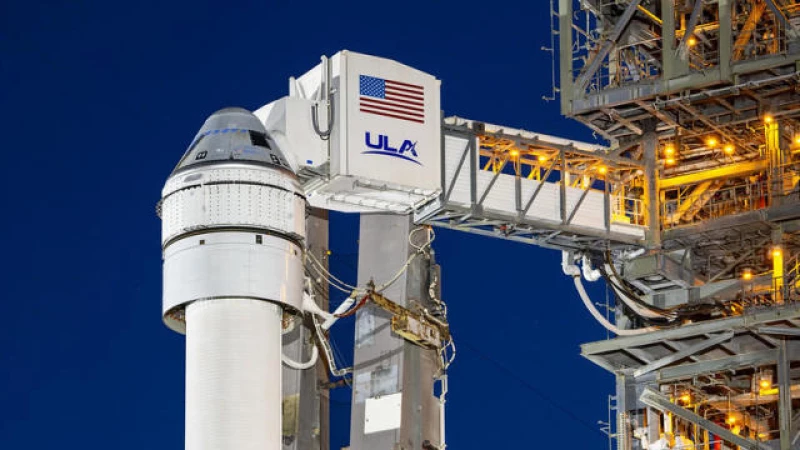An Atlas 5 rocket carrying astronauts for the first time in six decades was primed for blastoff Monday night to boost Boeing's long-delayed Starliner crew ferry ship into orbit for its first piloted test flight to the International Space Station.
Running years behind schedule and more than a billion dollars over budget, the Starliner is Boeing's answer to SpaceX's Crew Dragon, an already operational spacecraft that has carried 50 astronauts, cosmonauts and civilians into orbit in 13 flights, 12 of them to the space station.

NASA funded development of both spacecraft to ensure the agency would be able to launch crews to the outpost even if one company's ferry ship was grounded for any reason.
Astronauts ready for launch
While it's taken Boeing longer than expected to ready their ship for crew flights, all systems were go for launch from pad 41 at the Cape Canaveral Space Force Station at 10:34 p.m. EDT.
At the controls will be mission commander Barry "Butch" Wilmore and Sunita Williams, both veteran Navy test pilots and active-duty NASA astronauts with four earlier spaceflights to their credit, 11 spacewalks between them and a combined 500 days in orbit.
Like SpaceX's Crew Dragon, the Starliner is equipped with a "full-envelope" abort system capable of quickly propelling the capsule away from its booster in the event of a major malfunction at any point from the launch pad to orbit.
But if all goes well, the Atlas 5's Centaur upper stage will release the Starliner into a preliminary orbit 15 minutes after liftoff. The astronauts then will monitor two quick thruster firings to fine-tune the ship's orbit before taking turns testing the spacecraft's computer-assisted manual control system.
As with any other space station rendezvous, the Starliner will approach the lab from behind and below, looping up to a point directly ahead of the outpost and then moving in for docking at the Harmony module's forward port at 12:46 a.m. Wednesday.
During final approach, Wilmore and Williams will again test the capsule's manual controls, making sure future crews can tweak the trajectory or the spacecraft's orientation at their own discretion if needed.
The Starliner also is equipped with a fully manual backup system that allows the crew to directly command the ship's thrusters using a joystick-like hand controller, bypassing the spacecraft's flight computers. Wilmore and Williams will test that system after departing the station around May 15 to begin the trip back to Earth.
The Future of Space Travel: NASA's Plan for Crew Rotation Flights
Following the successful test flight of the Starliner, NASA is gearing up to certify it for regular crew rotation flights. The plan is to launch one Crew Dragon and one Starliner each year to transport long-duration crew members to the International Space Station for six-month tours of duty.
"An absolutely critical milestone"
Jim Free, NASA's associate administrator for space operations, has hailed the Starliner Crew Flight test, or CFT, as "an absolutely critical milestone" in the journey towards reliable human space transportation.
While expressing confidence in the Starliner's capabilities, Free remains cautiously optimistic, emphasizing the need to successfully complete a mission before celebrating. However, he highlighted the significance of having two distinct human space transportation systems once Starliner is certified, ensuring critical redundancy for ISS access.
Despite the challenges faced along the way, NASA's efforts to develop independent spacecraft for crew transportation have been ongoing since the retirement of the space shuttle in 2011. Contracts were awarded to SpaceX and Boeing in 2014, with the aim of fostering innovation in space travel and enhancing the capabilities of the ISS program.
The target date for initial piloted CCP flights was 2017. Funding shortfalls in Congress and technical snags delayed development, including an explosion during a ground test that destroyed a SpaceX Crew Dragon.
But the California rocket builder finally kicked off piloted flights in May 2020, successfully launching two NASA astronauts on a Crew Dragon test flight to the space station.
Since then, SpaceX has launched eight operational crew rotation flights to the station, three research missions to the lab funded by Houston-based Axiom Space and a purely commercial, two-man, two-woman trip to low-Earth orbit paid for by billionaire pilot and businessman Jared Isaacman. In all, 50 people have flown to orbit aboard Crew Dragons.
It's been a different story for Boeing's Starliner.
During an initial unpiloted test flight in December 2019, a software error prevented the ship's flight computer from loading the correct launch time from its counterpart aboard the Atlas 5.

As a result, a required orbit insertion burn did not happen on time and because of unrelated communications issues, flight controllers were unable to regain control in time to press ahead with a space station rendezvous.
The Starliner faced software problems upon landing, which prompted a post-flight review revealing various issues. Boeing decided to conduct a second test flight at its own cost, but encountered stuck propulsion system valves in the service module. Despite engineers' efforts, the problem persisted, leading to the capsule being removed from its Atlas 5 and taken back to the processing facility for troubleshooting.
Further investigation revealed that moisture, likely from high humidity and heavy rain after rollout to the pad, reacted with thruster propellant to cause corrosion. This corrosion hindered the valves from opening as needed.
To ensure a successful launch in May, the valves in a new service module were replaced, and the system was adjusted to prevent water intrusion on the launch pad. The subsequent Starliner test flight in May 2022 achieved its objectives, docking at the space station and returning to Earth with precision.
However, post-flight inspections revealed new issues: concerns with parachute harness connectors and the risk of protective tape around wiring causing a potential short circuit. Addressing these problems delayed the first crewed flight from 2023 to 2024. Ultimately, Boeing invested over $1 billion in funding the extra test flight and necessary corrective measures.







